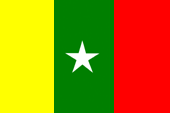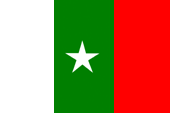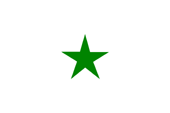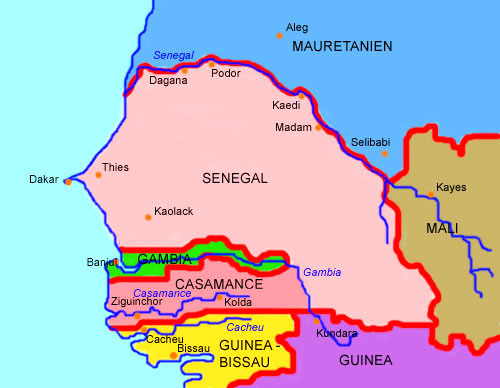mobile View, to the German Version tap the flag


- sezessionist region in the south of Senegal
• Flags
• Meaning/Origin of the Flag
• Map
• Numbers and Facts
• History
• Origin of the Country's Name

1983,
National flag,
ratio = 2:3,
Source, by: Flags of the World




1988,
National flag,
ratio = 2:3,
Source, by: Flags of the World




2001,
National flag,
ratio = 2:3,
Source, by: Flags of the World




The initial flag of the Casamance is the flag of the Partei MFDC (Mouvement des Forces Démocratiques de la Casamance). It was adoped in 1983. The design of the flag of 1983 has its roots clearly in the flag of Senegal from which the Casamance wants to separate. It showed the division in three vertical stripes in the Pan-African colours colours and in the middle field a star, but here in white. Yellow stands for wealth and prosperity, green for woods and agriculture, red for blood. The white star represents the people of the Casamance. The colours green, yellow and red are the Pan-African colours. The Pan-African-Movement had its beginnings perhaps in 1900, which wants to emphasize the common goals of all black people. The colour-triad green-yellow-red, which are used by many African and even American countries in their flags after independence, stands for the political unity of Africa, of all black People. The first country was Ghana in 1957. As the origin, the colours of Ethiopia (Abessinia), the oldest independent state in Africa, apply. In the year 1988 the yellow stripe was replaced by a white stripe. The colour white stands for peace, justice, freedom and unity. In 2001 the MFDC splited in fractions. Those fraction, which wants to continue the fight for an independent Casamance under arms, shows today a white bunting with a green star in the middle.
Source:
Flags of the World,
Die Welt der Flaggen

clickable Map:

Source: Volker Preuss

Area (claimed): ca. 10.946 square miles
Inhabitants (in the claimed area): 1.664.600 (2013)
Religions: 75% Muslim, 17% Christian (mostly Roman Catholic), 8% Animist
Density of Population: 152 inh./sq.mi.
Capital (theoretical): Ziguinchor, 205.294 inh. (2013)
Languages: French, Manding, Wolof, Fulbe
Currency: no own currency
Time Zone: GMT
Source: Wikipedia (D)

14th–15th century · parts of the today’s Casamance belong to the Mali-State
1460 · Portugese merchants establish at the Cacheu River in the today's Guinea-Bissau the base of Cacheu, in the afteryears waxing portugese influence towards the Casamance River
17th–19th century · the area of the Casamance becomes not colonially exploited, but special British and Portugese influence
1886 · France incorporates the Casamance into its colony of Senegal
1889 · border treaty with United Kingdom towards Gambia
1895 · establishment of the Government General French West Africa
1902 · establishment of the colonial federation of French West Africa consisting of: 1st) Mauritania – French Sudan – Niger Colony – Uppervolta, 2nd) Senegal, 3rd) Dahomey, 4th) Ivory Coast, 5th) French Guinea
1947 · foundation of the MFDC-Party (Mouvement des Forces Démocratiques de la Casamance)
20th of June 1960 · Senegal becomes an independent state
1980–2000 · rule of the President Abdou Diouf in Senegal
1982 · imprison of the command of the MFDC
1990–1993 · Casamance-Conflict, the region Casamance trys to separate from Senegal, the MFDC leads the armed struggle, support by troops of Guinea-Bissau
1994 · peace agreement of MFDC with the government of Senegal
1995 · because the peace agreement with Senegal contained none autonomy for Casamance parts of the MFDC continue the armed struggle
2001 · peace agreement of MFDC with the government of Senegal
2002 · because the peace agreement with Senegal contained none autonomy for Casamance the MFDC splits, parts of the MFDC continue the armed struggle against Senegal, there arise struggles between de MFDC-Fractions
Source:
Atlas zur Geschichte,
Wikipedia (D),
Flags of the World

The name of the country "Casamance" has its roots in the Casamance River. He is the lifeline of the country. The name "Casamance" was introduced by the Portugese and derives from the Manding word "Cassamoukou", what means "rice". The Casamance is so the "rice land". Manifestly the River Casamance offers good conditions for rice-farming because the country is the most important rice-farming-zone in the region. It is geographical separated in two regions, the Upper Casamance (Haute Casamance, region of Kolda) and the Lower Casamance (Basse Casamance, region of Ziguinchor).
Source:
Wikipedia (D),
Flags of the World,
Länder der Erde


![]()











